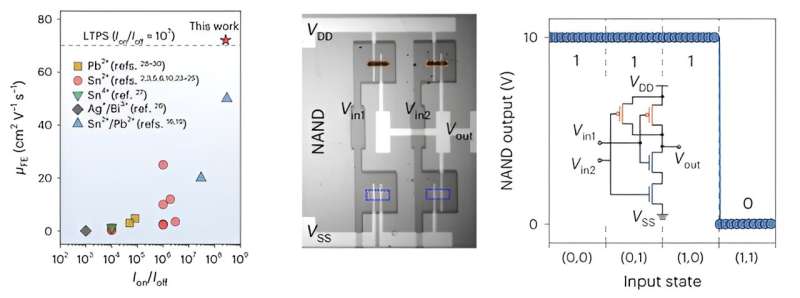September 11, 2023 feature
This article has been reviewed according to Science X's editorial process and policies. Editors have highlighted the following attributes while ensuring the content's credibility:
fact-checked
peer-reviewed publication
trusted source
proofread
A strategy to fabricate highly performing tin perovskite-based transistors

Metal halide perovskites are semiconducting materials with advantageous optoelectronic properties, low defects and low costs of production. In contrast with other emerging semiconductors, these materials can be easily synthesized via affordable solution processing methods.
In recent years, some engineers have been exploring the potential of metal halide perovskites for creating highly solar cells and light emitting diodes (LEDs). Their favorable characteristics, however, could also facilitate their use for fabricating next-generation electronic components, including transistors.
Researchers at Pohang University of Science and Technology in South Korea, the Chinse Academy of Sciences and the University of Electronic Science and Technology of China recently introduced a new strategy to develop transistors based on a metal halide perovskite, specifically tin perovskite. In their paper, published in Nature Electronics, they showed that the resulting tin perovskite-based transistors could attain performances comparable to those of existing silicon-based transistors.
"As they are intrinsic semiconductors, the application of metal halide perovskites as a semiconducting channel layer for thin film transistors is expected," Yong-Young Noh and Ao Liu, the two primary authors of the paper, told Tech Xplore. "However, due to the unclear material design route and processing strategy, previous efforts cannot compete with commercial low-temperature poly-Si devices. In addition, previous works only focused on single devices and could not really achieve their one-chip circuit integration; this is not beneficial to evaluate the devices' real application potential."
A key objective of the recent work by Noh, Liu and their colleagues was to introduce a new approach for creating high-performance p-channel transistors, using low-cost halide perovskites. Transistors are widely used switching devices used to control the amount of electrical current flowing inside electronics.
The researchers created their new transistors using films of a pure tin-based perovskite, Notably, the films are affordable and easy to source, thus they could help to substantially reduce the fabrication cost of transistors.
"Our metal halide perovskite transistors work with the same principle of operation as conventional silicon-based field-effect transistors," Noh and Liu explaind. "Transistors are the core of microelectronics devices and are the most basics unit in our daily diverse electric products. Notably, we found a way to rationally design the A-cation component to modulate the crystallization dynamic. The band edge of halide perovskite is mainly composed of B-site cation and X-site anion. Therefore, we believe the A-cation engineering is an ideal strategy to enable the high-quality film fabrication, without influencing its intrinsic high mobility."
In addition to being low-cost, the pure tin-based perovskite used by the researchers does not harm the environment. To be successfully applied in electronics, their crystallization needs to be reliably modulated, so that they can be successfully used to create high-quality and uniform films.
In initial tests, the transistors created by Noh, Liu and their colleagues performed remarkably well, exhibiting hole mobilities of more than 70 cm2and on/off current ratios of more than 108. Remarkably, their performance is similar to that of low-temperature polysilicon-based transistors that on the market today.
"Compared with other applications, we believe the intrinsic high hole mobility of tin perovskite is very ideal candidate for transistors," Noh and Liu said. "We proposed of a new A-cation design strategy that enables the highest performance in any transistors using metal halide perovskites reported so far, The performance of our transistors is comparable to that of polysilicon transistors currently used in OLED driving circuits. We expect our strategy can inspire the future design of perovskite channel for high-performance transistor application."
In the future, the design and fabrication methods introduced by this team of researchers could pave the way for the realization of the very first perovskite-based integrated circuits. Their paper could eventually inform the development of new electronic components that are affordable and easy to integrate with existing CMOS (complementary metal-oxide semiconductor) technology, including driving circuits for OLED displays.
"We believe that tin-based perovskite should become the mainstream candidate for high performance p-channel transistor application," Noh and Liu added. "We recently published a perspective paper, where we analyze this research area in greater depth. In our next studies, we plan to continue optimizing the transistors' performance to determine the highest mobility that we can attain, while also improving their air stability for more practical applications. In addition, the device was manufactured through a solution process, and we want to eventually obtain the same performance reproducibly in the vacuum deposition process, which can be mass-produced commercially."
More information: Huihui Zhu et al, Tin perovskite transistors and complementary circuits based on A-site cation engineering, Nature Electronics (2023). DOI: 10.1038/s41928-023-01019-6
© 2023 Science X Network




















